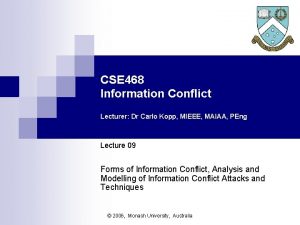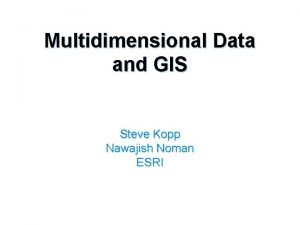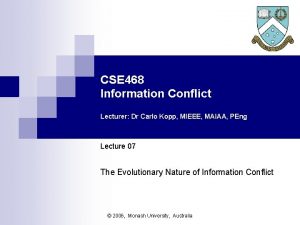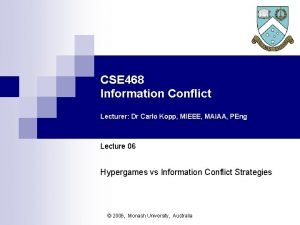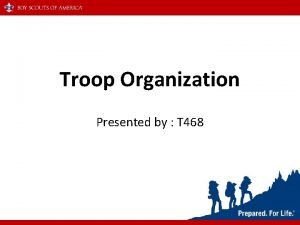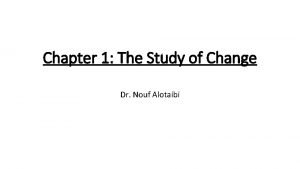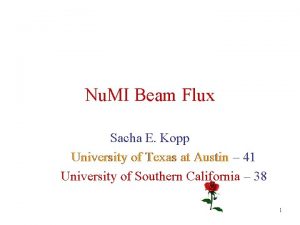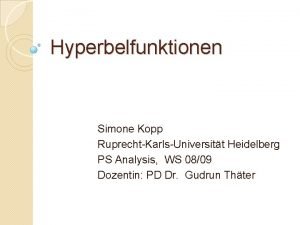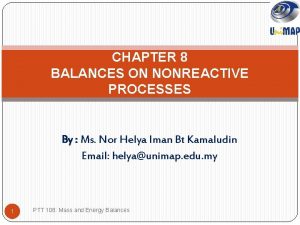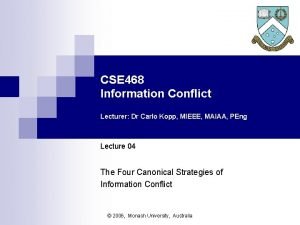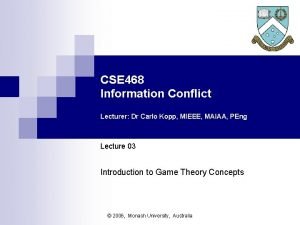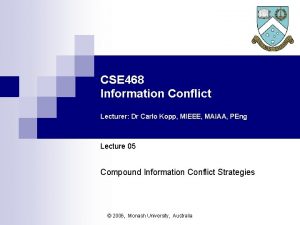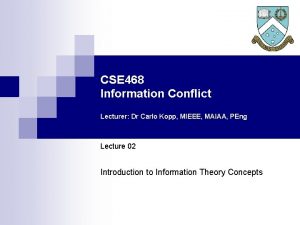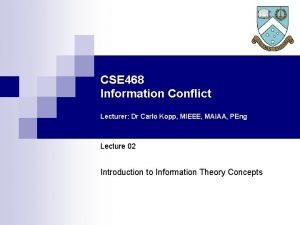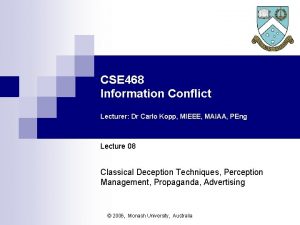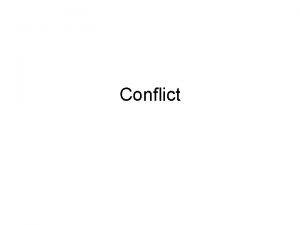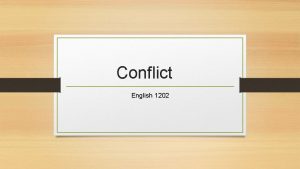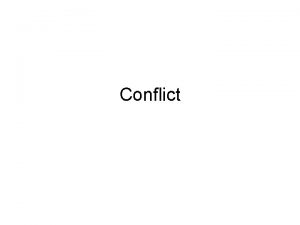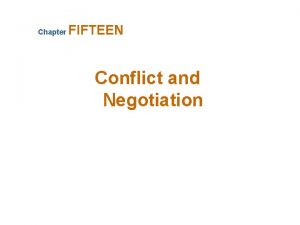CSE 468 Information Conflict Lecturer Dr Carlo Kopp


























- Slides: 26

CSE 468 Information Conflict Lecturer: Dr Carlo Kopp, MIEEE, MAIAA, PEng Lecture 09 Forms of Information Conflict, Analysis and Modelling of Information Conflict Attacks and Techniques © 2006, Monash University, Australia

Reference Sources and Bibliography n n Winn Schwartau, Information Warfare: Cyberterrorism : Protecting Your Personal Security in the Electronic Age, New York, NY: Thunder's Mouth Press, 1995, Second Edition. Carlo Kopp’s publications at http: //www. ausairpower. net/iw. html 3/12/2021 © 2006, Monash University, Australia 2

Why a Taxonomy? n n Given the diversity of possible ways in which information and its supporting infrastructure can be attacked, a taxonomical division is an important means of organising one’s understanding of the problem. While specific forms of attack might all map back to the canonical four strategies, the severity and context of the attack may vary considerably. There are many arbitrary classifications applied to sorting modes, regimes and types of attack. Schwartau’s class model is widely used and representative. 3/12/2021 © 2006, Monash University, Australia 3

The ‘Class Model’ of Information Conflict n n Class I IW - Compromising Personal or Corporate Privacy is the lowest grade of IW, and occurs when for instance your personal account is compromised and confidential information accessed. Class II IW - Industrial and Economic Espionage is the next step up, in which instance government or corporate computers are hacked into and information covertly stolen. Class III IW - Info-Terrorism and Denial of Services. The intentional destrcution of another party's computer or network, or denial of service via other means is usually described as info-terrorism. The offending party may be a malicious hacker, a criminal extortionist, a genuine terrorist or a foreign government seeking to take down a system or systems. Military IW - The use of all of the above combined with other military techniques in order to disrupt an opponent's military operations, government activity and economy qualifies as military IW. Military IW is the most destructive as it involves both soft and hard kill techniques. 3/12/2021 © 2006, Monash University, Australia 4

Classes of IW 3/12/2021 © 2006, Monash University, Australia 5

Class I Information Warfare n n n Class I IW involves breaches of privacy and confidentiality targeting individuals, usually with the aim of stealing money or bandwidth. Example – a hacker steals a credit card number to deplete the available credit to his advantage. Example – a phracker steals account information to charge calls against an individual’s account (phracking). Example – a whacker penetrates a wireless network to steal bandwidth (whacking). Example – a bogus website emulating a finance organisation or company website is constructed to steal passwords and credit card numbers (phishing). Example – spammers substituting email addresses. 3/12/2021 © 2006, Monash University, Australia 6

Class II Information Warfare n n n Industrial and Economic Espionage is a more severe form of attack, in which instance government or corporate computers are hacked into and information covertly stolen. While the methodology may be similar or the same to many Class I attacks, the amounts of money or the value of the information stolen are significantly higher. A key problem with Class II attacks is that victims may not be prepared to report an attack to avoid their clientele losing confidence and withdrawing funds. Class II attacks are performed typically by professional criminals or government agencies. Examples – widely reported past attacks on banks, NASA, US Do. D, DOE and other computer systems. 3/12/2021 © 2006, Monash University, Australia 7

Class III Information Warfare n n n Info-Terrorism and Denial of Service attacks. The intentional destruction of another party's computer or network, or denial of service via other means is usually described as info-terrorism. The offending party may be a malicious hacker, a criminal extortionist, a genuine terrorist or a foreign government. Examples – ping of death attacks (historical), packet storm attacks, physical attacks on systems. Case Study – during the NATO bombing of Serbia, the NATO website was attacked using a range of techniques. Case Study – during the invasion of East Timor attacks on Australian systems increased in frequency. 3/12/2021 © 2006, Monash University, Australia 8

Military (Class IV) Information Warfare n n n Military IW covers the whole spectrum of possible attacks. Soft Kill attacks may fall into Class II and Class III categories. Hard Kill attacks have included the use of smart bombs and cruise missiles to cripple communications nodes such as civilian and military telephone switches and satellite terminals. Military IW includes techniques such as propaganda and psychological warfare (psywar). A recent development is the penetration of opposing military networks to generate false target information. 3/12/2021 © 2006, Monash University, Australia 9

Denial of Service Attacks n n n Denial of service attacks are an offensive technique intended to cripple an organisation by preventing it from using its digital systems. Denial of Service attacks are increasingly common especially involving attacks on websites, and large scale attacks on networked systems using viruses and worms. Where an organisation depends on its digital infrastructure such attacks can produce significant material losses. Recently documented Denial of Service attacks have been associated with nation state conflicts, and political, religious or ideological disputes. Many attacks are performed by malicious individuals for personal gratification. This is especially true of virus/worm attacks which are performed for no material gain but costs hundreds of millions in lost productivity and repair time. 3/12/2021 © 2006, Monash University, Australia 10

Denial of Service Attacks n n Denial of Service (Do. S) attacks may be categorised as hard kill or soft kill, depending on the means used. The aim is either temporary or permanent denial of service provided by a facility, be it a network, communications link, computer system, or other information gathering, transmission or processing asset. Broadly Do. S attacks can be divided into logical/electronic attacks (eg hacking, virus, worm, radiofrequency jamming), direct physical attacks (eg cutting cables, smashing equipment, bombing sites), radiofrequency or electromagnetic attacks (eg E-bomb, HERF gun). The downtime of the victim asset is determined by the severity of the attack, be it hard kill or soft kill. 3/12/2021 © 2006, Monash University, Australia 11

Denial of Service Attacks 3/12/2021 © 2006, Monash University, Australia 12

Logical/Electronic Attacks n n n This category of attack is typically in the soft kill category, although some such attacks may require days to recover from. Viruses can be used to damage operating system installations and user files. Worms can be used to cripple systems, consuming memory, disk and bandwidth. Logic bombs and other destructive trojan horse programs can be used to damage operating system installations and user files. Radiofrequency jammers can be used to cripple voice, digital communications and networks. Such attacks can be launched globally due to the vast footprint of the Internet and communications network. 3/12/2021 © 2006, Monash University, Australia 13

Direct Physical Attacks n n n Such attacks are typically hard kill attacks, intended to destroy specific pieces of equipment or cables. Example – putting a fire axe, blowtorch or sledgehammers to bundles of cables – be they for data or mains power supply. Example – attacking a computer system with an axe or sledgehammer. Example – sending a suicide bomber or truck bomber against a telephone switch, computer centre or television studio. Example – dropping a smart bomb on a telephone switch or satellite uplink (Baghdad 2003). The attacker must be in direct contact with the victim system/target. 3/12/2021 © 2006, Monash University, Australia 14

Radio Frequency Denial of Service Attacks n n n Jamming of radio frequency communications channels has been practiced for almost a century, usually in wartime. During the Cold War the Soviets continuously jammed Western radio broadcasts. Jamming involves transmitting a signal which interferes with the modulation used by the signal, degrading intelligibility. A wide range of jamming techniques exist against all known modulation types. Designers of military communications equipment plan from the outset to deal with jamming. This is generally not true of commercial equipment which usually has very poor jam resistance. Jamming equipment to disrupt mobile phones (GSM, CDMA etc) is now widely available and is built to prevent terrorists from using mobile phones to set off bombs remotely. Wireless 802. 11 networks are highly susceptible to jamming due to the use of short Barker code modulations. Denial of Service attacks against mobile phones or wireless networks can be effected quite cheaply using ‘throwaway’ expendable jammers and can be very difficult to prove. 3/12/2021 © 2006, Monash University, Australia 15

Electrical Denial of Service Attacks n n n The dependency of computer and digital communications equipment upon electrical power feeds and electrical data cables makes it vulnerable to electrical denial of service attacks. Such attacks aim to inject high voltage or radio frequency signals into mains power or data cables to cause electrical damage or computer crashes and loss of service. Example A: a Tazer device with a cable harness and connector allowing it to inject high voltage into a local area network via a wall socket can destroy network adaptors in dozens of computers. Example B: a shortwave radio transmitter connected to mains voltage power can destroy power supplies in computer or communications equipment. The best defence is to deny access to electrical power and data cables to ensure an attacker cannot connect his equipment. Proving such an attack can be difficult. 3/12/2021 © 2006, Monash University, Australia 16

Radio Frequency Weapons – Denial of Service n n n Denial of service can also be effected by radio frequency (RF) weapons which emit enough RF power to damage or disrupt the function of computing and communications equipment. RF radiation can couple into mains and data cabling, or cooling apertures on equipment, causing equipment to crash or fail permanently with electrical damage. HERF guns are portable devices which emits pulsed or continuous wave RF radiation. Tesla coils can be used to emit high voltage RF fields with similar effects to HERF guns. A hidden battery powered Tesla coil can cripple equipment inside buildings for as long as the battery lasts. Radio frequency weapons were claimed to have been used during the 1990 s for criminal extortion against at least one bank. To date there are no confirmed reports of E-bombs being used in combat operations, despite ongoing speculation. The best defensive measure is electromagnetic hardening of computer and communications equipment – the electrical equivalent of armour plating. 3/12/2021 © 2006, Monash University, Australia 17

Electromagnetic Weapons 3/12/2021 © 2006, Monash University, Australia 18

Electromagnetic Bombs n n 1. 2. Nuclear EMP weapons – nuclear bombs initiated at very high altitude can blanket footprints of almost continental size. Electromagnetic bombs (E-bombs) can produce damage over areas the size of city blocks, or greater. E-bombs remain in development for military applications. Two categories exist: Flux generator bombs – produce localised fields similar to lightning strikes. Microwave bombs – produce microwave radiation fields of high intensity over footprints of hundreds of metres diameter. 3/12/2021 © 2006, Monash University, Australia 19

E-bombs – Low Frequency 3/12/2021 © 2006, Monash University, Australia 20

E-bombs - Microwave 3/12/2021 © 2006, Monash University, Australia 21

Modelling Information Conflict 3/12/2021 © 2006, Monash University, Australia 22

Systematic Modelling n n n The best strategy is to follow a systematic approach. The first step is always the gathering of data to provide as complete a picture of the situation as is possible. The second step is to identify specific strategies, usually at the canonical level, since these are more readily identified. The second step is to identify players – attackers and victims. The third step is to identify the structure of compound strategies. Determining the aim of a complex compound strategy can often be quite difficult. 3/12/2021 © 2006, Monash University, Australia 23

Validation Of Models n Two basic scenarios for validating a model: Validating a model of a strategy in progress. 2. Validating a posteriori a past strategy. 1. n n The first case is usually much more difficult due to incompleteness of data and intentional efforts to conceal the nature of the strategy by the attacker. If intelligence information is available to penetrate defences, then analysis of strategies in progress is much simplified. Strategies in which information is hidden completely will always present analytical difficulties both a priori or in progress. This is the essence of strategic surprise, as defined in the hypergame framework. Without evidence to prove that a deception strategy is underway, it is not feasible to perform analysis. 3/12/2021 © 2006, Monash University, Australia 24

Validation vs Uncertainty n n With poor data, the evolving strategy under analysis is uncertain. Effectively, analysis will require the definition of several alternative models for the compound strategy, all sharing those features which existing data can logically support. As the strategy evolves further, alternatives will collapse as actions by the player contradict the respective alternative models. The analyst therefore produces a tree structured graph identifying possibilities, and the graph is progressively pruned as incoming data causes specific branches of the tree to collapse. 3/12/2021 © 2006, Monash University, Australia 25

Tutorial n n Q&A E-bomb Paper 3/12/2021 © 2006, Monash University, Australia 26
 Lecturer's name or lecturer name
Lecturer's name or lecturer name Carlo kopp
Carlo kopp Gridded data
Gridded data Carlo kopp
Carlo kopp Carlo kopp
Carlo kopp Bsa organization chart
Bsa organization chart Convert 240 k and 468 k to the celsius scale.
Convert 240 k and 468 k to the celsius scale. Cs 468
Cs 468 Physician associate lecturer
Physician associate lecturer Spe distinguished lecturer
Spe distinguished lecturer Good afternoon teacher and my friend
Good afternoon teacher and my friend Photography lecturer
Photography lecturer Lecturer in charge
Lecturer in charge Designation lecturer
Designation lecturer Designation of lecturer
Designation of lecturer Why himalayan rivers are pernnial in nature
Why himalayan rivers are pernnial in nature Lecturer name
Lecturer name Pearson lecturer resources
Pearson lecturer resources 140000/120
140000/120 Lector vs lecturer
Lector vs lecturer Lecturer in charge
Lecturer in charge Cfa lecturer handbook
Cfa lecturer handbook Lecturer asad ali
Lecturer asad ali Sacha e. kopp
Sacha e. kopp Hyperbelfunktionen
Hyperbelfunktionen Kopp's rule example
Kopp's rule example Kopp's rule example
Kopp's rule example

